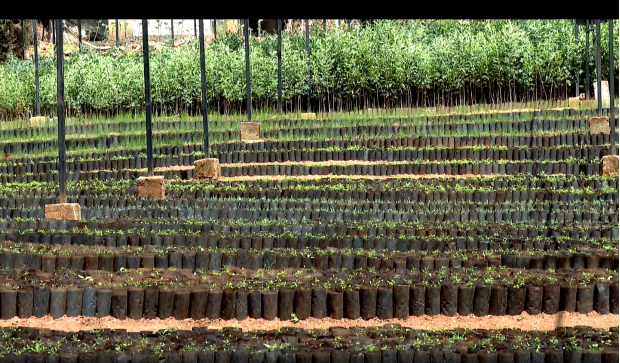
Ethiopia has combated climate change for the past fifty years. Planting tree saplings across the country has received attention from the country’s consecutive governments, regardless of political and ideological leanings or economic policies.
Both the Derg and the EPRDF governments have made every effort to combat the detrimental effects of climate change, among other things. They recognized how sensitive the country is to the detrimental effects of climate change and the unpredictable nature of climate variability. Because the country is not a developed country, its ability to protect against the negative effects of climate change has been hampered by restricted livelihood options for the majority of the people, an insufficient ability to tolerate or absorb disasters, and the prevalent biophysical shocks.
Unlike the previous governments, the incumbent developed the Green Legacy Initiative, a well-understood and tangible initiative to address the detrimental effects of climate change throughout the country. As a result, Ethiopia has been planting various tree saplings across the country since the launch of the Green Legacy Initiative in 2019. The initiative’s initial phase aimed to plant 20 billion tree seedlings between 2019 and 2022. Nonetheless, the country accomplished this by planting 25 billion tree seedlings.
In addition to addressing the negative consequences of climate change, the campaign encourages a person to plant fruit trees, which contributes to the country’s food security and nutrition. It has contributed to economic growth and food security. The initiative’s principal goal is to create a green and climate-resilient economy.
The initiative is also imperative for reversing the negative effects of climate change and environmental degradation, which cause flooding, soil erosion, deforestation, and biodiversity loss. Furthermore, it is utilized to mitigate the effects of climate change, drought, and desertification.
Drawing on the lessons learned from the first Green Legacy Initiative (GLI), Ethiopia began its second phase of the Green Legacy Initiative in 2023. Expanding tree planting initiatives and boosting community involvement were the main goals of this phase. During this phase, the country will plant billions of trees across the country by involving organizations, schools, and residents. While raising public awareness of environmental issues, the initiative seeks to restore degraded lands and highlights the significance of sustainable land management.
During the launch of the second phase of the Green Legacy Initiative, Ethiopian Prime Minister Abiy Ahmed (PhD) stated that “Let’s plant our future today” is the theme for the second phase of the Green Legacy Initiative, which follows a successful first phase in which we planted 25 billion seedlings.”
He also stated that Ethiopia will plant an additional 25 billion seedlings during the second phase. “Green Legacy is our local approach to tackling climate change and environmental degradation.” Planting edible seedlings is one of our approaches for creating job opportunities and ensuring food security.
Indeed, Ethiopia’s larger commitment to environmental sustainability and its objectives under international climate agreements are reflected in either the first or second phase of the Green Legacy Initiative. Through better ecosystem services, it aims to improve local populations’ livelihoods while promoting resilience against the effects of climate change. Since 2019, the country has been planting tree saplings annually 6 times.
Accordingly, the country is also making extensive preparations to plant 7.5 billion tree seedlings nationwide in the upcoming Green Legacy (GL) planting season.
The Ethiopian Forestry Development (EFD) Green Legacy and Degraded Lands Rehabilitation Desk Head, Goraw Belete, told the Ethiopian Press Agency (EPA) that 4.7 billion of the total 7.5 billion seedlings have already been prepared for the seventh Green Legacy planting season.
Goraw further stated that EFD has gathered 2,247 quintals of diverse seeds for this fiscal year, including forestry, bamboo, and multipurpose agroforestry seeds. Additionally, about 441,000 hectares of land have been identified and compiled for the campaign so far.
He emphasized the extraordinary increase of sapling stations, which has more than doubled from 45,000 before the Green Legacy Initiative to over 120,000 now, involving government, business, NGO, and other enterprises. Currently, the institution is carrying out many initiatives to ensure the program’s success, including mapping 947,000 hectares of land for planting.
He said half of the 441,000 hectares will be planted using a geo-referencing method. Furthermore, soil and water conservation measures are being developed to increase the vegetation potential. “Nearly 133,000 jobs are expected to be created across eleven regions this budget year.”
Since its inception in 2019, the Green Legacy Initiative has created 1.3 million permanent and temporary job opportunities in beekeeping, seed germination, river development, and other related fields, he explained.
The Ethiopian Ministry of Agriculture, Natural Resources Development, Conservation, and Utilization Sector Lead Executive Officer Fanose Mekonnen said that the country has been preparing seedlings in various nurseries for this year’s Green Legacy initiative tree planting campaign. He added that this year’s preparation is being implemented more comprehensively and coordinated than ever before.
He explained that more than 40 billion seedlings have been planted over the past six years through the initiative. This year, the Ministry aims to prepare 7.5 billion seedlings. Among others, the six billion seedlings prepared so far this year, 40 percent are allocated to forest development, while the remaining 60 percent are intended to plant species for improving soil fertility, producing animal fodder, and cultivating fruit plants. Besides, planting seedlings will begin this month in regions that are receiving rainfall and suitable for sapling growth, he said.
According to Fanose, the Green Legacy Initiative has played a crucial role in boosting environmental conservation efforts, notably increasing Ethiopia’s forest coverage from 17.2 to 23.6 percent, emphasizing its impact on soil and water conservation, and the planting campaign will be enhanced by the strong community participation during the rainy season.
The Green Legacy Initiative has helped reduce soil erosion and created employment opportunities, he added, indicating that it also supports food security efforts by encouraging the cultivation of fruit-bearing plants. Ethiopia has also shared its success stories with other countries, contributing to the global climate change mitigation efforts.
In general, the Ethiopian government started the Green Legacy Initiative, an environmental protection program that aims to address climate change, ensure food security, build a climate-resilient economy, encourage reforestation, and combat deforestation. Since its launch in 2019, the project has grown into a larger endeavor to increase biodiversity and green cover in Ethiopia. It also improves local communities’ livelihoods through better ecosystem services while promoting resilience against the effects of climate change.
Therefore, the government, stakeholders, the people, and international organizations that work in environmental protection should support this year’s intuitive to make the planting activities more successful and efficient.
BY EPHREM ANDARGACHEW
THE ETHIOPIAN HERALD SUNDAY EDITION 27 APRIL 2025





